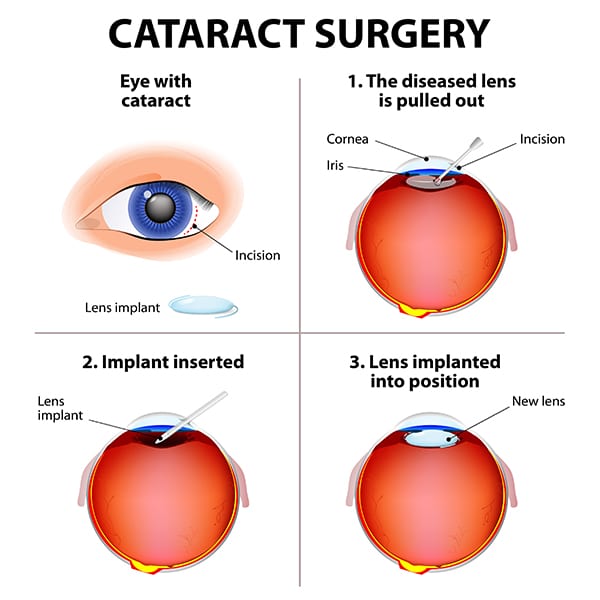
The Papale Eye Center team is committed to offering the safest and most effective treatment for cataracts. At our practice, serving Western Massachusetts, we perform cataract surgery using modern surgical techniques that are designed to make your experience comfortable and pain-free. In just a few hours, we can gently remove your cataracts and restore your vision with minimal discomfort and maximum results.
We are excited to offer our cataract patients many options for lens implants, including the ReSTOR® lens implant. With these lens implants, cataract patients can experience clear vision at all distances, even for close-up reading!
What is a cataract?
The lens of our eye lies behind the iris and the pupil and its job is to focus what the eye is seeing on the light-sensitive retina at the back of the eye. A normal lens is crystal clear. Cataracts change that. Over time and often as a result of prolonged exposure to UV radiation, most people begin to have clouding of the lens in one or both eyes. This happens as proteins in the eye form clumps that begin to cloud the lens. As the proteins build, the lens becomes cloudier, eventually affecting visual acuity, especially at night.
Cataracts are common in older people. In the U.S., it’s estimated that an 80-year-old has a 50/50 chance of either having cataracts or already having had cataract surgery. Cataracts can only be treated with surgery to replace the permanently clouded lens.
What Causes Cataracts?
The development of cataracts is a normal part of the aging process; however, cataracts may sometimes develop early as a result of:
- Disease
- Trauma to the eye
- Medications
- Exposure to UV light
Cataracts develop in nearly everyone, but they occur more often in people with diabetes and the only way to treat them is with cataract surgery. Although people can live with some cataracts if they are not that bad, if cataracts become worse, they can impede your vision significantly.
A cataract cannot be treated with exercise, diet, or lasers, and it is not a film that covers the eye that can be removed. The most effective way to treat cataracts is to remove the natural lens of the eye and replace it with an artificial lens that is not cloudy called an Intraocular Lens (IOL).
What are the symptoms of cataracts?

Cataracts will not cause you any pain. Cataracts also develop very slowly as proteins build in the lens of the eye. Often the person doesn’t even realize how cloudy his or her vision has become. These are typical symptoms of cataracts:
- Decreased color vibrancy
- Blurred vision
- Poor night vision
- Increased glare
- Halos surrounding lights
- Double vision
- Frequently changing eyeglass prescription
- A feeling there is a film over the eye
When will I know if I should have cataract surgery?
Everyone is different, but this is truly a question of quality of life. Cataract-clouded lenses lessen the colors you see. They make it difficult to drive and see at night. As mentioned above, it’s like you’re looking through a smudged, dirty window. When your cataract has developed to the point where it is blurring your vision, creating glare around lights when driving, impacting reading, and other issues, it’s time to have surgery. What’s to be gained by waiting?
What are the benefits of having cataract surgery?
You could say, “What are the benefits of having clear vision again?” Once cataracts have clouded your vision it can seem as if you’re continually looking through a dirty window. When Dr. Papale removes the clouded natural lens and replaces it with an artificial intraocular lens (IOL) your vision in that eye is instantly clear again. Plus, the new IOLs can provide clear vision at all distances, and they can even correct for presbyopia, the near-universal condition where we need reading glasses for up-close vision after we turn 40.
What to expect from the cataract procedure
Cataract surgery is considered the safest and most effective treatment for cataracts. It is among the most commonly performed surgical procedures in the United States, with over 1.5 million cataract surgeries taking place each year. At Papale Eye Center, we perform cataract surgery on an outpatient basis.
- A small incision is made in the eye
- Then the cloudy lens is broken up and quickly removed.
- This cataract removal procedure is ultrasound-based and requires no stitching.
- A flexible lens replacement is then inserted through the incision and unfolded into place. This lens replacement is referred to as an intraocular lens or lens implant.
- Once in place, the lens implant naturally adheres to the eye. In the majority of cases, the eye incision heals on its own, requiring no stitches.
Will I feel any pain during cataract surgery?
Cataract surgery has advanced to the point where there is little if any discomfort involved in the entire procedure. Many patients will not have to receive any injections to numb their eyes (anesthetic drops will be used instead) or deal with stitches to close the small incision in the eye (the incision will heal naturally). This no-stitch cataracts treatment technique, which was first introduced to the Springfield, Massachusetts area by Dr. John Papale, is not only safer for the patient but also produces less discomfort and quicker recovery.
What is recovery like after cataract surgery?
Recovery after cataract surgery is not difficult at all. After your surgery with Dr. Papale, he’ll place an eye patch on your treated eye. He’ll also have you wear a protective shield when sleeping for several days. At first, your vision will be blurry, but it rapidly improves in just a couple of days. Your eye may be somewhat itchy, but you must not rub or put any pressure on the treated eye. Heavy lifting, or anything that puts pressure on your eyes, must be avoided. We’ll prescribe eye drops to prevent inflammation and infection and to control your eye pressure.
Full healing can take up to two months, but you can return to most daily activities in just a few days. Depending on your lens choice, you may or may not require glasses for some tasks after your surgery. If both your eyes have cataracts, we schedule the second eye for surgery after the first; they are not done at the same time.
How much does cataract surgery cost?
Medicare or private medical insurance, or a combination of both usually covers the cost of cataract surgery. Your cost varies based on the intraocular lens choice you make. The newer, multifocal IOLs will not be fully covered by Medicare, so you will have some out-of-pocket cost, but most people say that’s well worth it to not need reading glasses for most near tasks.
Why should I choose Papale Eye Center for my cataracts treatment?
For years, Papale Eye Center has remained at the forefront of cataract treatment. We have gone out of our way to incorporate new technology into our practice to make cataract treatment safer and more effective. Our premier eye surgeon, Dr. John Papale has performed more than 10,000 LASIK and cataract surgery procedures over the course of his career. He is the surgeon of choice for many doctors and nurses throughout the Springfield, Massachusetts area. If you are considering cataract surgery, Dr. Papale and the Papale Eye Center staff will answer all of your treatment questions, assist you with financing, and help you explore the many benefits that cataract surgery has to offer, including clearer vision at all distances with the ReSTOR® lens implants.
Contact Us Today!
To learn more about cataracts, schedule a consultation at our Springfield, Massachusetts eye center. To learn more about cataract surgery and intraocular lenses visit our Tecnis Symfony IOL page. You can also contact our Springfield, Massachusetts eye surgery center today. Serving patients from Springfield, Chicopee, Agawam, Longmeadow, Ludlow, Westfield, MA, and the surrounding areas.
